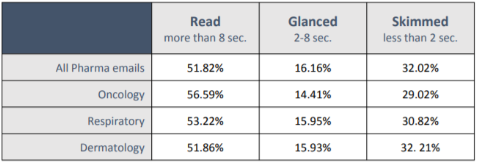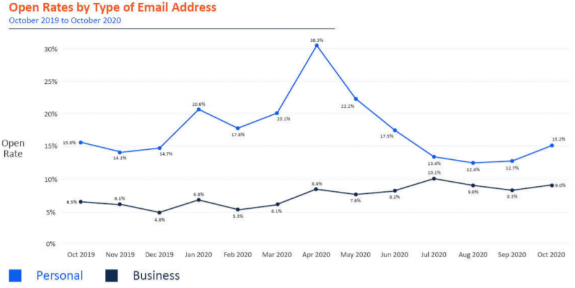
2020 represented an unprecedented year for many reasons. 
COVID-19 loomed large in everyone’s life and proved to be greatly influential for healthcare marketing. DMD’s analysis of the more than 32 million emails deployed from October 31, 2019 to October 31, 2020 revealed informative trends. These emails were sent to U.S.-based physicians, nurse practitioners, physicians’ assistants, nurses, and pharmacists on behalf of pharmaceutical companies and brands.
Our 2020 Email Year in Review report summarizes year-to-year trends, delves into engagement metrics influenced by COVID-19, and provides a look to what may be ahead for healthcare marketers in 2021.
Year-over-Year Trends
One of the key metrics DMD continuously monitors when assessing deployment success is open rate. Data from 2019 showed an average open rate of 9.4% among emails DMD deployed to HCPs on behalf of our pharmaceutical clients. Open rates began a steady climb as early as January 2020, reaching a peak in April of 18.9%. This represents a 300% increase compared to April 2019 (6.99% open rate). Since April, open rates have declined but still remain higher than historic measures of years’ past.
Looking at the three specialties most requested by our clients during this time—oncology, respiratory, and dermatology—we found total engagement to be higher than previous years. Open rate, click-to-open rate (CTOR), and read times all saw an increase.
Read time engagement, defined as the percentage of HCPs spending eight seconds or more reading an email, rose from an average of 36% (using data from 2016-2019) to nearly 52% in 2020.

The increase in engagement is likely due to fewer in-person sales visits, as well as a demand for information related to the virus from credible sources. While the number of pharma campaigns with the word “COVID” in the subject line have been greatly reduced, our Audience Identity ManagerⓇ XR (AIM XR) data shows that COVID-19 is still a highly sought after and relevant topic among HCPs.
Inbox Challenges Remain an Issue—but One Not Impossible to Overcome
The analysis shows that deliverability continues to be a challenge when deploying to consumer platforms like Gmail and Yahoo/AOL. Gmail consistently makes changes to its filtering algorithm and has adopted a “message stream” view that alters inbox placement. The platform briefly loosened its overall filters to better disseminate important pandemic information, which resulted in high inbox placement and engagement. By mid-July Gmail resumed more strict filtering practices.
Yahoo/AOL isn’t quite as frequent in algorithm modifications or stringent with its filters, but the platform still presents obstacles. It, too, is moving toward the message stream approach.
Fortunately, DMD has developed deployment strategies to adapt to such challenges. Pharma companies don’t have to “give up” on these consumer platforms—they just need to know DMD can overcome the disruptions. This is especially crucial, since data reveals personal emails were far more active than professional ones during the pandemic. We expect that trend to continue in 2021.

Email Strategies for 2021: What’s Next
No one could have predicted 2020’s events, and it’s challenging to forecast exactly what 2021 will bring. However, we do know that email’s low cost, high engagement, and target-level reporting will make it one of the most important communication channels in 2021—if not the most important one.
Email is a highly valuable channel within a broader HCP omnichannel strategy.
Based on the success rates of DMD’s triggered email programs in 2020, we also expect these campaigns to become mainstream in the coming year. When triggered email is combined with broadcast email, it produces the highest engagement rates DMD has measured among pharma deployments.
Two additional strategies we anticipate pharma companies to implement in 2021 include:
- Matching programmatic and social segments with a corresponding email segment. This trend has been very effective thus far.
- Send time optimization (STO) and strategic send time optimization (SSTO). Both drive improved open rates, which subsequently boosts deliverability and engagement.
Is This the New Normal for HCP Engagement?
We do not know if 2020’s email engagement numbers will hold steadfast into 2021. What is known is that email is a highly valuable channel within a broader HCP omnichannel strategy.
In order for email marketing to achieve the most success, it’s crucial for pharma marketers to be data-driven in their efforts. If your marketing resources don’t allow for routine analysis of each deployment, or how to use that data to inform future deployments, 2021 is the time to enlist the help of email experts. If you don’t, it’s likely your competition will.


![[Download] 2020 Email Year in Review Report](https://no-cache.hubspot.com/cta/default/357405/de776112-6fa0-47d9-8fe5-58bf5f70c90c.png)

